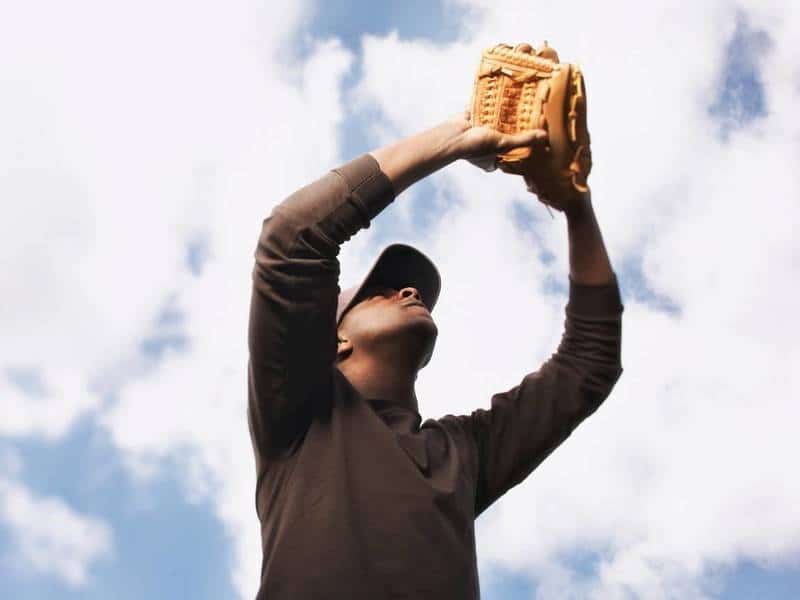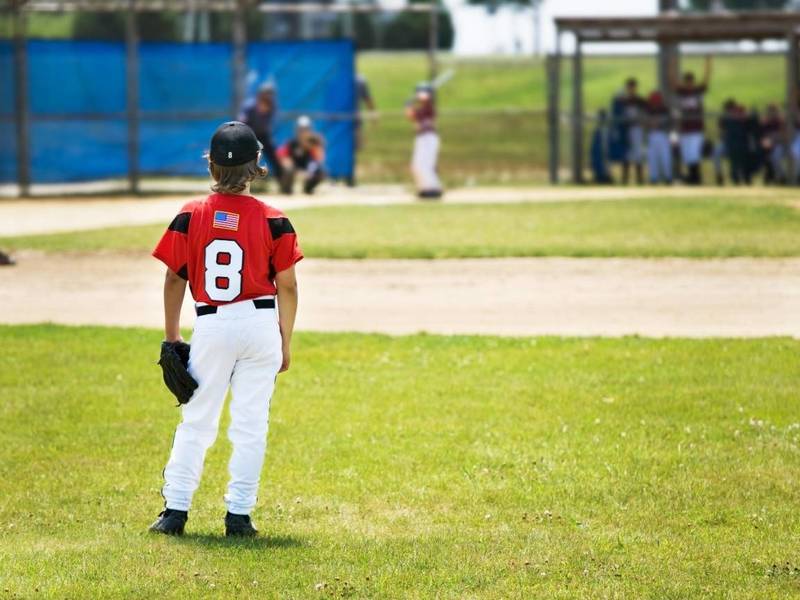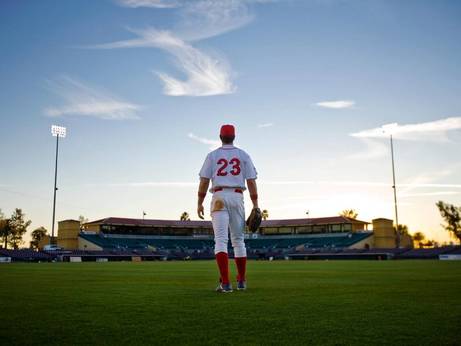
I’d have to say that playing in the outfield was the highlight of youth baseball for me. There was and remains no greater feeling than tracking down a fly ball you have no business catching. To know that you’re playing a position that requires you to be on your A-game is exhilarating!
So I bet you’re wondering – how do you teach players to play the outfield?
The best things you can do to teach players to play the outfield are to teach them how to properly run down and catch fly balls. There are right and wrong ways to go after batted balls. Good outfielders also understand game situations and use that knowledge to keep runners from gaining extra bases.
Learning to play the outfield optimally isn’t easy but it’s something you can make happen. It all comes down to how much work you’re willing to put into your game on and off the field. This article will offer a lot of insight in how to play and coach the position.
Always Know the Situation
Every baseball player on the field should be ready and know the situation before each pitch. Outfielders (OFs) are no exceptions to this rule. Outfielders should adopt a ready position as the pitcher begins their motion.
Ready positions for outfielders differ from infielders as they tend to have more time to react and don’t have balls whizzing by their faces.
There will be some differences between OFs, but the ready position typically consists of feet being slightly staggered, knees bent and hands on the thighs.
Outfielders should avoid resting their hands on their knees as this can result in lost time on batted balls. Along with the ready position, outfielders should know what they’re going to do with the ball before each pitch if it comes their way.
For example, if there’s a runner on 1st and the batter hits a single to the outfield (OF), the outfielder who fields the ball should throw to 3rd or hit the cutoff man.
The OF should also always be aware of how many outs there are, the inning and the count. Outfielders also need to know who is on base at all times.
Good OFs should know which players have wheels on the opposing team and which players like to dog-it. Teach your players to always hustle after the ball as the best players will take extra bases however they can get them.
Lastly, you need to teach your outfielders to get the ball into the infield right away. They should already know this by high school but make sure to emphasize the importance of this for Little League.
Hesitation on the part of the OF usually occurs when runners are on base. Make sure your players know that holding onto the ball is one of the worst things you can do in the OF.
First Step Back on Fly Balls
A good rule of thumb for OFs is to take their first step back. The more advanced players will be able to read the ball off the bat, but coaches should highlight the importance of taking the first step back for younger players.
So why should players take their first step back? The main reason is because it’s much easier to come in and catch a ball than to go backwards and catch a ball.
When taking their first step back, players should keep in mind the drop and crossover steps.
The drop-step is an easy concept to understand but may take younger players awhile to nail down in practice. It’s just taking your first step back.
The reason younger outfielders might have some issues with this is because they tend to false-step. That means they’re taking a quick step in before they start to work backward.
Once your players have the drop-step down, talk to them about the crossover-step. This step takes place immediately following the drop-step and involves bring the non-drop-step leg over the drop-step leg.
Once your OFs perform these two steps in succession, they can run after the ball as normal.
We want to put the focus on making the first step back because it reduces the likelihood that balls go over your head. It’s much better to take your first step back and give up singles than to take your first step in, misjudge the ball and then give up doubles and triples.
Fielding Groundballs in the Outfield
When it comes to fielding groundballs in the OF, it’s better to be safe than sorry.
There will be situations where you need to field the ball on the run to try and throw runners out, but in situations where there are no plays to be made, drop to your knee and get in front of the ball to ensure you collect it. This will help prevent singles from becoming doubles or worse.
Generally, if there are no runners on base and someone hits the ball to the OF, the chances of getting that player out are very low.
Playing it safe is usually the way to go on balls hit in front of you in the OF, but there are situations where a more aggressive approach is warranted.
In situations where your outfielders feel like they can throw someone out, instruct them to run up to the ball, plant their glove-side foot and then field the ball outside this foot.
Once they collect the ball, they should utilize their momentum by bouncing up and going straight into their throwing motion.
Catching the Ball: Two Hands or One?

There are many opinions out there concerning catching fly-balls with one or two hands. Many of the people who hold these opinions are usually all-in on one of these methods, but that’s not the way you should look at it.
Whether an outfielder catches a ball with one or two hands is often situational.
When coaching younger players, I’d tend to emphasize catching fly-balls with two hands. Two hands should be the preferred method when there are two outs or there are no runners on base.
To catch a fly-ball with two hands you generally need to be in a good position. Catching a ball with two hands also allows you to quickly transfer the ball to your throwing hand and get it into the infield.
Using two hands (especially in Little League) will reduce the amount of dropped balls. Using two hands could benefit players at any level – even the majors.
We’ve all seen professional players drop routine fly balls due to laziness. Don’t let this happen to your players. Teach the importance of using two hands.
Although two hands are preferred for the younger ages, you should still let your players know when to use one hand and the benefits it offers. Using one hand is a better option for catching a ball on the run because a one-hand approach gives you greater range.
A one hand approach also doesn’t obstruct your vision as an outfielder.
Backing Each Other Up in the Outfield
Outfielders should be constantly backing each other up. You never know when a ball is going to get past someone and go to the wall. For this reason, you should preach to your OFs that they should always be moving.
This also keeps OFs engaged even when the ball isn’t hit in their direction.
So when a ball is hit to left-field (LF) or RF, the centerfielder (CF) needs to back up the play. And for balls hit to LF, RF needs to back up 2nd base. The same can be said of LF for balls hit to RF.
The corner OFs serve as backups for 2nd base because there may be a play at 2nd when a runner tries stretching a single into a double.
Along with balls to the OF, OFs need to back up their respective bases. Right-field should backup 1st base when the ball is batted into the infield.
Centerfield should back up 2nd base when the team is turning a double play or a runner is trying to steal. Left-field should back up 3rd base when a runner is trying to steal.
While backing up the bases and each other in the OF doesn’t always result in anything (which is good), it’s better to be moving and ready for the worst case scenario than standing around doing nothing.
Taking Good Paths to the Ball
You need to teach your OFs how to track balls down in the OF. They should work their way to the ball at an angle instead of running directly at the ball. If you run directly at the ball, you’re likely going to end up watching it bounce or roll to the wall.
For fly-balls, your players should always run hard to where the ball is going to land. You don’t want to keep pace with a ball to make an over the shoulder or diving catch.
You want to get out in front of the ball whenever possible so you can square it up. The more movement and elements that an act of catching a ball calls for, the less likely you’re going to make the catch.
The same applies for ground balls. If you take a direct path to the ball, it’s just going to roll to the wall and you’re going to give up extra bases.
By taking a diagonal route/cutting the ball off, you get to the ball as quickly as you can and prevent runners from taking extra bases.
Throwing Ahead of Runners
Outfielders generally want to throw the ball ahead of the lead runner by two bases. This is the best way to keep base-runners on the other team honest.
For example, if a ball is hit to the OF with no one on, the ball should be thrown into second. That’s because the runner started at home plate. So home plate + 2 bases = 2nd base.
Now let’s say there’s no runners on and the batter hits a double to the wall, which is collected by CF. At this point CF should hit the cutoff man, who should throw the ball into the infield.
If CF instead decides to throw to 2nd base, he’s giving the runner the entire flight of the ball to reach 3rd base. This can apply for any base.
Here’s a general guide (assuming a single is hit to the OF):
- No runners on = throw to 2nd base
- Runner on 1st = throw to 3rd base
- Runner on 2nd = throw home or 2nd base/cutoff man
- Runner on 3rd = throw to 2nd base
Catching a Ball on the Run

When coaching your players on how to catch balls on the run, you need to drive home the fact that your players should never stop moving their feet. Your OFs should do their best to get out in front of the ball rather than keeping pace with it.
Your players should also have a mindset that no ball is uncatchable. Balls off the bat that seem impossible to catch at first, may be fairly easy to catch once you start moving toward the ball.
When you take the ball’s trajectory and the wind into account, it’s not crazy to think a ball may hang up in the air longer than originally thought.
It also pays to completely run out a fly-ball. Each step you take in tracking down a fly-ball, the overall picture becomes clearer. By giving 100% on balls hit to the OF, you’ll ensure that you have the best chance of catching it.
The Centerfielder: Captain of the Outfield
While the shortstop is the captain of the infield, CF is the captain of the OF. Centerfield is responsible for directing traffic in the outfit and any ball that he calls is his. If LF or RF calls a ball first but then CF calls the ball, that’s the CF’s ball.
Centerfield has the final say on balls hit to the OF because his position offers him a better perspective of the field. If he thinks he has a better shot at the ball than one of the corner OFs, he should call the ball.
Once this happens, the other OFs should back up CF.
Centerfield also shouldn’t be shy about communicating with the other OFs. He should relay hitter tendencies to the other OFs and direct traffic as needed.
A player who is very knowledgeable of the game and has no issue with covering a lot of ground is likely to make a good CF.
Hitting the Cutoff Man in Baseball
One of the biggest pet peeves of coaches is when OFs don’t hit their cutoff men. Smart runners will have no issue with taking additional bases if the OF doesn’t throw the ball in correctly.
With that said, the OF doesn’t always have to hit the cutoff man. If the OF thinks he has a play or is fairly close to the infield, he can throw directly to the base in front of the lead runner.
He should still throw the ball with some velocity and avoid throwing a rainbow. Needlessly throwing a rainbow ranks up there with throwing behind runners. Don’t do it. Make sure to keep the ball low and get the ball in quickly.
Cutoffs should work on lining themselves up between the player in the OF with the ball and the ball/plate where a play could happen. The cutoffs also need to position themselves sideways with their glove hand closer to the infield.
Outfielders should work on throwing directly at the glove so cutoff men don’t have to twist around to make a throw. This will maximize the chance of throwing runners out.
The Importance of Outfielders
Talk to your OFs about the importance of the position. A lot of younger players tend to think being put in the OF is punishment but that’s not the case. The OF is the last line of defense. If a player is getting put there, it means the coach trusts them.
The younger age groups will see less balls hit to the OF, but the balls that are hit there carry a lot of weight. If an infielder messes up on a groundball, an out turns into a single.
If the OF messes up on a ball, an out or single turns into a double, triple or homerun.
The OF is perfect for kids who understand the game, are fast and athletic and who aren’t afraid to put their bodies on the line. Having players like these in the OF does wonders for your pitcher’s confidence.
At the lower levels, you shouldn’t play your players solely in the OF. That’s because at the lower levels fewer balls are hit to the OF. Once kids start reaching high school, the number of balls hit to the OF drastically increases.
